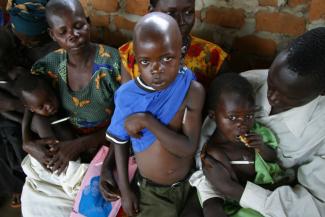Uganda
More malaria and infectious diseases

Moses Kabangi, the Assistant Commissioner of the Inspection, Sanitation and Hygiene Division of Uganda’s Ministry of Health, is concerned with the health situation in his country.
“Health protection is a major challenge for us,” he explains. Climate change is already significantly noticeable in Uganda. According to Kabangi’s data, since 1960, the annual average temperature has climbed by 1.3 degrees, and temperatures are predicted to be 2 degrees warmer by 2030. As a result, the glaciers in the Ruwenzori Mountains, the third-highest mountain range in Africa, have disappeared by more than half since 1987, and they are expected to continue their rapid melting. Kabangi reports that annual precipitation has declined by an average of 3.4 millimetres per month within a single decade. That means that there will be more flooding and landslides, the expert explains, which in turn will create favourable conditions for certain diseases.
In Uganda, Kabangi says, there are more and more cases of malaria, including in areas that were once malaria-free, like high altitudes. “Malaria is also becoming deadlier”, he stated in March at the online conference of the Poverty Reduction, Equity and Growth Network (PEGNet) on the topic of “Climate risks and policies – Towards resilient low-carbon economies”. One reason for the increased incidence of the disease are the higher temperatures, which support the growth of malaria mosquitoes.
More swarms of mosquitoes are also fuelling the rise of lymphatic filariasis (LF), a tropical disease that is triggered by an infection with various species of parasitic worms (filarial worms), which are transmitted to humans by a mosquito bite. According to estimates, cases of LF will increase by 17 % in Uganda between 2000 and 2050. The Ministry of Health is also expecting an uptick of infectious diseases like cholera and typhus, which are caused by contaminated water.
Kabangi also points to the risk of increased malnutrition among the poorest groups, since the harvest of staple foods has declined as a result of extreme weather. Malnutrition, in turn, causes many other diseases (see Simone Welte in E+Z/D+C e-Paper 2020/11, Focus section).
According to Kabangi, the government’s preventive health measures are as follows:
- policy action: integration of climate protection and adaptation measures into health policy and all affected policy fields,
- involvement of communities and expansion of local capacities,
- development of early warning systems to prevent natural disasters and
- promotion of renewable energies like solar and hydroelectric power plants.












